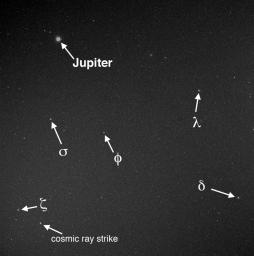Searching for Vulcanoids
Caption:
In mid-February, before and after MESSENGER's latest perihelion (closest approach to the Sun), an imaging campaign was conducted to search for vulcanoids, small rocky bodies that have been postulated to exist in orbits between Mercury and the Sun. Those images are still waiting to be transmitted to Earth. Read the
full news story
for details about the possible existence of vulcanoids and MESSENGER's unique opportunity to search for them. The image here is from the first set of 240 MDIS images taken to look for vulcanoids, acquired in June 2008. It is a 10-s exposure taken through the WAC's clear filter. Jupiter is bright and visible in the image. The camera field of view is nearly large enough to capture the entire width of Sagittarius, a constellation of the zodiac visible low and to the south in summer from temperate latitudes in the northern hemisphere. The Greek letters identify some of the brighter stars in Sagittarius.
During the vulcanoid search campaign, 4-5 images of the same scene are taken back to back. This procedure allows cosmic ray strikes on the camera's detector to be identified and enables fainter objects to be detected. One such cosmic ray strike is labeled on this image. In this single image, the cosmic ray strike appears similar to the stars, but in the four images taken immediately after this one, the cosmic ray strike is gone whereas the stars remain. Images are also taken hours and days apart, so the motion of objects in the sky can be determined. If a vulcanoid were imaged, its motion through the sky would appear very different from motions of the background stars and known Solar System objects. No vulcanoids have been found yet, but the latest set of acquired images will expand the volume of the search region examined so far.
Date Acquired:
June 4, 2008
Image Mission Elapsed Time (MET):
121050477
Instrument:
Wide Angle Camera (NAC) of the Mercury Dual Imaging System (MDIS)
WAC Filter:
2 (clear filter)
Field of View:
The WAC has a 10.5° field of view
Background Info:
These images are from MESSENGER, a NASA Discovery mission to conduct the first orbital study of the innermost planet, Mercury. For information regarding the use of images, see the MESSENGER
image use policy
.
Cataloging Keywords:
| Name |
Value |
Additional Values |
| Target |
Mercury |
|
| System |
|
|
| Target Type |
Planet |
|
| Mission |
MESSENGER |
|
| Instrument Host |
MESSENGER |
|
| Host Type |
Orbiter |
|
| Instrument |
Mercury Dual Imaging System (MDIS) |
|
| Detector |
Narrow Angle Camera (NAC) |
|
| Extra Keywords |
Grayscale |
| Acquisition Date |
|
| Release Date |
2009-03-03 |
| Date in Caption |
2008-06-04 |
|
| Image Credit |
NASA/Johns Hopkins University Applied Physics Laboratory/Carnegie Institution of Washington |
| Source |
photojournal.jpl.nasa.gov/catalog/PIA12038 |
| Identifier |
PIA12038 |

 Planetary Data System
Planetary Data System
